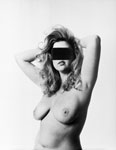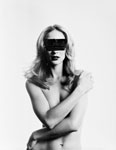
New York Times Article - Life on the Other Side of the Lens: Maxwell Snow, Photographer, Sets His Demons Aside
March 2, 2012 - April 7, 2012
In Max Snow’s 100 Headless Women the gallery walls become mausoleum walls, the space a sort of Egyptian tomb but with artifacts more mythological than memento mori. The walls are covered in rows of nude female torsos with obscured faces: a salon of ghostly mug shots. Church statues of saints have been soaked in diluted muriatic acid to dissolve their features. Snow has then carved and chipped away at them to achieve a more featureless, ghostlike form. In this context the faceless portraits almost become a shrine to the unknown masses of a civilization lost or a fable that was never told.
“When you look at a portrait you look at the eyes and the face,” says Snow. “Everyone says that the face and the eyes tell the story and that grief scars your eyes. So I like in this series to rob the viewer of that intimacy and to make it more mysterious and surreal.”
The faces without eyes, in their multitude, become even more haunting. One also recalls the fact that the blind are more advanced in their other senses and that, when blindfolded, one is more sensitive to touch. This idea folds in seamlessly with Max Snow’s body of work which itself exudes an innate sensuality, a dark eroticism and animal instinct in defiance of rational intellect. Snow’s photograph of himself embracing a statue comes to mind. Snow says of this portrait, “it’s strange because it looks more like I’m clinging to it and I’m not sure if it’s embracing me back.” Sometimes we need to dive into fantasy or the corporeal realm to escape the pain of the emotional or the dullness of the mundane. But as Snow points out, even these realms do not always offer us comfort.
The faces of the women in this series are obscured by different mediums, primarily etching ink, but they are not defaced with animosity. Rather, Snow has wrapped them in a cloak of anonymity to seal their singular identities. The viewer is then forced to focus on the collective group and the story or the myth that may have been. Snow’s obscuring of the faces of his subjects thus becomes an act similar to scratching the inscription from a tombstone. The dead person is no longer a dead person; it is Death. And Death, a territory unknown to the living, can be whatever we make of it.
Blogs:
Untitled Project Blog - Interview
Crime & Love: An Interview With Maxwell Snow | PAS UN AUTRE









